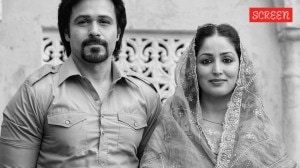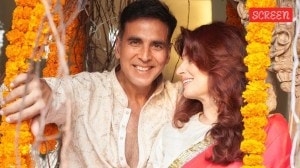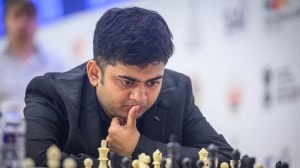Photo-artist Dayanita Singh: ‘The photographer of the future will be more of an archivist’
Photo-artist Dayanita Singh on the intersection of physical worlds in her architecture photography, her interactions with Mona Ahmed, how her mother Nony Singh and tabla maestro Zakir Hussain influenced her work and the future of photography.
 Dayanita Singh during her show ‘Photo Lies’ in Mumbai. (Express Photo/Amit Chakravarty)
Dayanita Singh during her show ‘Photo Lies’ in Mumbai. (Express Photo/Amit Chakravarty)For photo-artist Dayanita Singh, the essence of an image lies not in its singularity but in the myriad ways it can be perceived. Photographs function as catalysts, evolving into sculptural expressions within handmade wooden structures, ladders and montages or accordion-fold books that unfold into intimate exhibitions.
Constantly defying the conventions of the medium, last November the recipient of the prestigious Hasselblad Award embarked on an ambitious five-city tour across India with her “mini museums”, each designed to reveal a distinct narrative at every location. Last week saw the opening of two notable exhibitions: “A Photo Architect” at the Kanoria Centre for Arts in Ahmedabad, which features montages of her architectural works, and “Mona and Myself” at Gallery White in Vadodara, a poignant tribute to Mona Ahmed and their decades-long friendship, which began in 1989 when Singh was on an assignment for The Times (London) for a story on a eunuch in India.
In this interview, Singh, 63, reflects on her artistic journey and how “art is in its dissemination.”
At your exhibition in Ahmedabad, you present architectural montages that juxtapose different periods and locations, deliberately omitting specific details. Can you talk about your approach?
After photographing architecture for some years, I noticed my images sliding into one another. Standing at my table, filled with same-sized prints stacked in piles by location, I saw Kyoto dancing with Ahmedabad, (Alvaro) Siza conversing with (Geoffrey) Bawa, a cave temple embracing a hotel lobby. A single cut could dissolve time and geography, giving birth to impossible places — making explicit my long-held view of the inherent deception in photography. You also had to come to the gallery to see the physical works as the cut would not be visible in a reproduction. For once, a book was inadequate.
The exhibition also marks the premiere of your video on architect BV Doshi, with whom you shared a deep personal bond.
I first met BV Doshi in 2018, when I was photographing him at his house for a magazine. He sat in a chair I had chosen for the portrait and the first thing he asked was, “Tell me, how will you make a still photograph speak?” That was a moment of epiphany. What began as an assignment soon became a very significant and ongoing conversation.
The video grew out of our conversations during Covid, when we would connect over Zoom. I’d share photographs I had taken of Kamala House (Doshi’s house in Ahmedabad), and he spoke about the images. For his birthday in 2021, I created a book, Portrait of a House. It was then that I realised I had both the visuals and his voice discussing them, and I needed to explore what kind of a film this could become. I am very excited to show this video in Ahmedabad.
You have often mentioned how Mona Ahmed inspired you to think out-of-the-box. If you could tell us more about her and the exhibition in Vadodara.
‘Mona and Myself’ is the first time I am showing all the works ever made with Mona, starting from 1989 right until last week, when we edited the footage of the release of the book Myself Mona Ahmed (2001) that took place in a kabristan (cemetery) in Delhi, where Mona stayed. The exhibition also features a video, recorded on impulse, where Mona suddenly asked me to turn on the camera and recited shayari for 10 minutes.
She was the most unique person I have ever known. When we first met, she instantly became this lovely girlfriend I could spend hours talking with. Yet, the moment we stepped into the street, she transformed into a formidable figure, hurling abuses at anyone who dared whistle at me.
At a certain time Mona decided that she couldn’t live with the eunuchs anymore and shifted into the Mehendiyan Kabristan. Gradually, she built a home and alongside dug a swimming pool with the intention of teaching Muslim girls to swim and empower them. When I pointed out that no one would send their daughters there, she retorted, saying, “Never mind, then I’ll make a pickle factory here and you market it for me as Ahmed pickles.” Her belongings were often stolen, but instead of keeping her doors locked, she asked the man who built the graves to embed her gifts — everything from shampoo bottles to whiskey bottles — into cement walls. These became her exhibitions along with collages of my photographs cut from the Aperture book.
Mona passed away in 2017, yet, in a way, she hasn’t really gone. The Mona montages in this exhibition were created after her passing, with Mona at the centre. You’ll find her in the ‘Museum of Dance’ alongside others such as Masterji (Saroj Khan) and Madhuri Dixit, with Mona’s movements echoing those of Birju Maharaj, as they shared the same Kathak lineage.
 “Mona and Myself” at Gallery White in Vadodara is a tribute to Mona Ahmed and their decades-long friendship (CREDIT: Dayanita Singh)
“Mona and Myself” at Gallery White in Vadodara is a tribute to Mona Ahmed and their decades-long friendship (CREDIT: Dayanita Singh)
Your mother Nony Singh extensively photographed you as a child. Did that inspire you to pursue photography?
Not at all. In fact, being photographed was the only annoyance of my childhood! I grew up in a loving family of four sisters and parents who doted on us, so there was no real trauma. However, the only source of frustration was waiting for my mother to count her steps when she was photographing me because she used a manual focus camera. I absolutely hated it, and the last thing I wanted was to become a photographer. I’m actually acutely aware of how uncomfortable it is to be in front of the camera.
Looking back though, I realise that the albums and tabletop photo compilations my mother created were probably my first introduction to curation — she would constantly add or remove photographs.
You met tabla maestro Zakir Hussain when you were still a student of visual communication at National Institute of Design in Ahmedabad. You spent six winters touring with him and his peers, leading to your first photobook (Zakir Hussain, 1986). How did this early encounter shape your relationship with photography?
I love to say that I studied in the Zakir Hussain Academy of Focus. From Zakirji I learned to learn. But it’s only recently that I realised how much I was influenced by the musicians’ bus tours where I accompanied him. We would spend weeks travelling with some of the greatest musicians of the time, living in all kinds of places. We would start in Calcutta and end up in another corner of India, with several concerts in smaller towns intended at cultivating a larger audience for classical music. In many ways, what I’m doing now with my own exhibitions tour directly draws inspiration from those bus journeys.
If you could share your experience of studying at the International Center of Photography (ICP) in New York in the ’80s?
I decided to go to ICP because I knew I couldn’t truly pursue photography in India at the time. There were no women in the field and the men were hardly encouraging.
It was far too expensive and I remember negotiating with my mother, telling her, ‘I won’t get married, but if I ever do, I won’t take a dowry and to let me go to ICP instead’. Luckily for me, she agreed.
In hindsight, what I had learned at NID, plus the privilege of having Zakirji as a mentor, was all the education I needed. ICP, perhaps, gave me a certain confidence in pursuing photography as a career but I soon realised I was not cut out for photojournalism. That’s when (Swiss-American photographer) Robert Frank won the Hasselblad Award for Photographic Achievement in 1996 and granted me $10,000 to continue my series of family portraits that ultimately led to the publication of my book Privacy in 2004.
How was it to scan through your early work for the photo novel Let’s See (2022), which features over 100 images, from weddings to funerals and birthdays.
During Covid, I finally had the time to look at all my contact sheets. I saw that I was an excellent photographer long before I became a photographer. I was creating images that didn’t adhere to the conventions of what I was later taught made a photograph ‘good’, but there was a gentleness in my eye, a certain ease, tenderness even, in how I captured the world. I no longer have access to that eye. The images were very special and as always I wondered what their form might be and I decided to experiment with the idea of a photo novel. I called it Let’s See because, at its core, the project is about exactly that: how we perceive the world, what we fail to see and what only the camera can reveal.
Dissemination is a significant aspect of your work – from photo books to photo boxes, your projects invite interaction. Book Building (2022) came with instructions on how to transform books into exhibitions, including a suggestion to wear a long jacket adorned with the nine museums featured in the book. ‘The Suitcase Museum’ — a collection of book objects mounted on four wheels — has travelled the world over. How important is it for you to create these engaging experiences?
Dissemination is as much part of photography as the image is. Because of its reproducibility, it lends itself to dissemination more than other art forms. The book is perhaps the best form of dissemination of the image but I wanted more.
As early as 2000, I had an exhibition in Saligao (Goa) featuring people I had photographed there. At the end of the exhibition, they removed the images from the walls and took them home. So, my work is now in about 30 homes in Saligao. I did the same with ‘Ladies of Calcutta’ in 2008; my images now hang in 66 homes in Calcutta.
Then, of course, there is the dissemination of the book but I lean more towards the book object. That space between a print on the wall and a bookshelf, that’s where I want to be, and create a whole other collector base, democratise art.
I use photography as raw material, playing with it till the form reveals itself to me. Sometimes a photo novel and sometimes a ‘Museum of Furniture’ or most recently the constructed contact sheets. This approach is particularly pertinent today, when smartphones have democratised photography. I see amazing photographs on Instagram, every day.
What role do you see photo-artists playing in the future?
Perhaps, the photographer of the future will be more of an archivist. Nothing records time better than photography. The question is then to find something you can sustain for the next months, years, decades even. And this commitment to their idea actually comes quite naturally to photographers. Look at Gauri Gill’s recent work on the farmers’ protests or Ishan Tankha’s documentation of the time of Covid and CAA protests in Delhi. Sohrab Hura documents our times in his own way too. This documentary vein of photography is essential for society and photographers are finding their own new forms for it.
TAKE FIVE with Dayanita SinghThe most memorable photograph you have taken The girl on the bed, which became the start of ‘Go Away Closer’. With it I realised that I did not have to edit by subject, as was the norm at the time, but I could edit with an emotion like ‘Go away closer’ Architectural sites you have found inspiring The Ellora caves, Alvaro Siza Wing at the Serralves Museum in Portugal, and Bijoy Jain’s studio in Mumbai The photographs on your desk/studio A calendar I made for my mother of all my photographs that she has coloured with her highlighter pens. Who else would dare to colour my black-and-white photographs! One book on photography everyone must read Geoff Dyer’s The Ongoing Moment. It is the history of photography through themes in photography, written in “genre-defying Dyer style” If you could collaborate with a photographer, who would it be and why Sohrab Hura. He is a great editor and book maker. I am sure we could create something completely new. It may not even be related to photography |



- 01
- 02
- 03
- 04
- 05




























